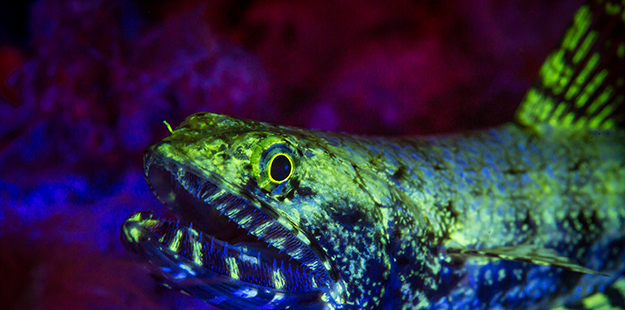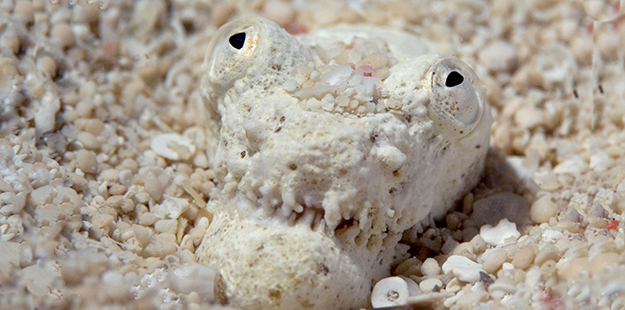Under Cover of Darkness
Trips to Zoo are often scheduled to arrive around dusk so divers can witness fish in their bedding down behavior. As twilight fades, a range of creatures from crabs and shrimp to colorful flatworms emerge from the sheltering tangles of staghorn coral. This site is one of the best in the region to find the elusive twinspot lionfish, while squid and octopus are common. A favorite are bobtail squids that put on an amazing show as they transition through a wide range of patterns and color changes, using reflective properties in the pigment cells of their skin like sequins on a party dress. They may also employ more muted hues to blend into the background so they can ambush prey or escape predators. Also worth watching—but never touching—is the blue-ringed octopus. Having no internal skeleton, they can modify their shapes in dramatic ways, and undergo changes in color and texture to match their environment. When threatened, this small octopus will display its namesake blue rings, providing a vivid warning of its highly toxic nature.

This lizardfish found at Zoo put on quite a colorful light show when illuminated with the special lighting used during fluo dives. Photo by Steve Miller
Zoo is also one of the sites used for one of the resort’s most unusual nocturnal experiences. The phenomenon of “fluo-diving” was pioneered at Wakatobi Resort. This program provides divers with special blue UV lights, along with a yellow filter that fits over a dive mask. When the lights are swept along a reef, certain corals and animals are revealed in eerie fluorescing colors, similar to the glowing images on a black light poster. Not all forms of marine life fluoresce, but those that do can put on quite a show. Coral branches seem lit from within, and shrimp that might be a bland brown when lit by a conventional dive light can take on a bright green glow, as if radioactive.
Special finds and sand dwellers
Another prime night dive location close to the resort is Dunia Baru, where a sloping shallow reef and an adjoining sand flat are home to several special finds. This is one of the best areas around Wakatobi Resort to find the pajama cardinalfish. You typically won’t find these colorful little fish during a daylight dive on this site, as they spend the sunlit hours hiding under ledges and deep within enveloping coral formations. When caught in the beam of a torch, it’s not hard to see how this fish got its common name. A black band around the fish’s middle body separates a yellow front from a back end that is dotted with vivid orange spots. When combined with red eyes that appear bloodshot, this creates the anthropomorphic comparison to someone just startled from sleep.

Hidden and difficult to spot in daylight, the sinister looking reptilian snake eel can be found during night dives at sites such as Dunia Baru. Photo by Mark Snyder
Dunia Baru is also a good location to look beyond the corals and explore nearby patches of sand bottom. One bizarre-looking animal often found here is the reptilian snake eel. This burrow dweller is difficult to spot in daylight, as it leaves only the tip of its snout out of its hole. After dark, it exposes its head and neck, working its jaws with seemingly sinister intent as it waits for a crustacean or mollusk to come within range. Another creature that will sprout up from the sand in the night is the feathered sea pen. Named for their resemblance to antique quill pens, these creatures are related to corals. By day, they stay buried in the sand. They emerge to bloom after dark, deploying their feather-like feeding tentacles. Although they are extremely delicate, if touched very gently, sea pens will emit a bright greenish light or bioluminescence. They may also force water out of themselves as a defensive act, deflating and retreating into their stalk-like body.
These are just a few of the many unique encounters that take place in the waters surrounding Wakatobi Resort after the sun goes down. We invite you to come, or come back, and discover the marine life treasures that are revealed under the cover of darkness.
Contact us at office@wakatobi.com or complete a quick trip inquiry at wakatobi.com.
Visit us on Facebook.



